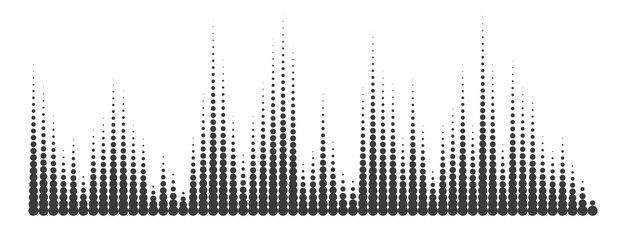Frequency distribution is one of the fundamental statistical tools used in data analysis. Whether you’re dealing with categorical or qualitative data, frequency distribution helps you organize and interpret it effectively. In this blog post, we’ll explore the uses of frequency distribution and its significance in gaining insights from data.
First, let’s understand what frequency distribution actually is. Essentially, it is a tabular representation that shows the distribution of data in different categories or class intervals and their corresponding frequencies. This allows you to identify patterns, trends, and relationships within the data.
Frequency distribution is particularly useful for categorical data, which consists of discrete categories. It helps you understand the spread of these categories and determine the most common or dominant ones. By analyzing the frequencies, you can discern the distribution and make informed decisions based on the data.
In this blog post, we’ll delve into the different types of frequency distribution, including those for categorical data. We’ll also explore the concept of K in frequency distribution, the 2 to the K rule, and how categorical data can be represented. Furthermore, we’ll discuss the advantages and disadvantages of using frequency distributions in data analysis.
So, let’s dive in and discover the uses of frequency distribution that can empower you to better understand and analyze your data in 2023 and beyond!

What are the Uses of Frequency Distribution?
Frequency distribution may sound like something only math geeks would get excited about, but trust me, it’s not just for statistics nerds. In fact, frequency distribution is a powerful tool that has numerous real-world applications. Let’s dive into some of the key uses of frequency distribution that may surprise you:
Analyzing Survey Data like a Sherlock Holmes
If you’ve ever conducted a survey – whether it’s about favorite pizza toppings or political preferences – you know how overwhelming the raw data can be. This is where frequency distribution swoops in like a detective solving a case. By organizing the data into groups and showing the frequency of each group, frequency distribution helps you spot patterns, outliers, and other hidden insights. It’s like putting on a pair of statistical spectacles and seeing the truth behind the numbers.
Understanding Customer Behavior with a Wink and a Nod
Understanding your customers is essential for any business, and frequency distribution can be your secret weapon in this quest. By using frequency distribution, you can analyze customer purchase patterns, preferences, and even complaints. For example, imagine you own an online shoe store, and you want to find out which shoe size is most commonly purchased. With frequency distribution, you can quickly see which sizes fly off the virtual shelves and which ones gather dust. Armed with this knowledge, you can make data-driven decisions and keep your customers’ feet happy.
Predicting Lottery Numbers (Well, Kinda)
Now, I’m no fortune teller, but frequency distribution can lend a hand in finding patterns in the chaos of lottery numbers. Picture this: you have a spreadsheet with the winning numbers for the past ten years (because you’re a lottery fanatic, obviously). By applying frequency distribution, you can uncover which numbers show up more frequently and which are as elusive as a unicorn peeking through the clouds. Although it won’t guarantee you a jackpot, at least you can play with a little more strategy and a pinch of statistical wizardry.
Spotting Trends in Pop Culture (Without Being an Influencer)
Have you ever wondered why certain trends become viral while others flop like a fish out of water? Well, frequency distribution might just hold the answer. By observing the frequency of hashtags, mentions, or views over time, you can track the rise and fall of trends in pop culture. Whether it’s the latest TikTok dance or a meme that has the internet buzzing, frequency distribution can help you understand the dynamics behind what’s hot and what’s not. Who knows, you might even become the trendsetter everyone wants to follow!
Tracking Your New Year’s Resolutions (No, Really!)
Let’s be honest, we all make New Year’s resolutions with the best intentions, only to forget about them by February (if we’re lucky). But fear not! Frequency distribution can come to your rescue. With a little meticulous record-keeping and some frequency analysis, you can track your progress and hold yourself accountable. Whether it’s hitting the gym, learning a new language, or reading more books, frequency distribution turns your resolutions into trackable data. Who said math couldn’t help you become a better version of yourself?
So there you have it, my friend. Frequency distribution is far from boring and has plenty of practical uses beyond the math classroom. From analyzing survey data to predicting lottery numbers (sort of), spotting trends, and even tracking your own progress, frequency distribution is your trusty sidekick in the world of data analysis. So go forth and embrace the power of numbers, armed with the knowledge of frequency distribution!

FAQ: What Are the Uses of Frequency Distribution?
What Kind of Frequency Distribution Table Is Used for Categorical Data
When dealing with categorical data, we use a frequency distribution table. This table summarizes the data by counting the frequency of each category. It provides a clear picture of how often each category occurs, making it easier to analyze and interpret the data.
What Is K in Frequency Distribution
In frequency distribution, K represents the number of categories or classes. It helps determine the number of intervals or groups to divide the data for analysis. So, if you have K = 5, you’ll have five groups to classify your data.
What Is the 2 to the K Rule
Ah, the famous 2 to the K rule! It sounds like some secret code, doesn’t it? Well, it’s not that complicated. The rule states that if you have K categories, it’s best to have 2 to the K number of intervals to avoid oversimplification or excessive detail. It strikes a balance between simplicity and intricacy, allowing you to uncover meaningful insights from your data.
How Can Categorical Data Be Represented
Categorical data can be represented in a variety of ways. You can use bar charts to visually display the frequency of each category. It’s like a popularity contest for categories! Another option is a pie chart, where each category is shown as a slice of the pie, with the size of the slice representing its frequency. So, you can have your data and eat it too!
What Are the Various Types of Frequency Distribution
Ah, let’s embark on a tour of the various types of frequency distribution. First, we have the simple frequency distribution, which displays the frequency of each category. Then we have the relative frequency distribution, which shows the proportion or percentage of each category. Finally, the cumulative frequency distribution keeps a running total of the frequencies as we move through the categories. It’s like leveling up in a video game—you get to see how far you’ve come!
What Is the Frequency Distribution of Qualitative Data, and Why Is It Useful
The frequency distribution of qualitative data is a blessing in disguise for researchers. It organizes and summarizes qualitative data into meaningful patterns, allowing us to uncover hidden truths. It helps identify the most common categories, outliers, and potential relationships within the data. So, if you want to decode the secrets of qualitative data, frequency distribution is your best friend!
What Are the Uses of Frequency Distribution
Ah, the million-dollar question! The uses of frequency distribution are as diverse as the flavors of ice cream. It helps us understand the distribution and patterns within our data, making it a valuable tool in research. It aids in descriptive statistics, hypothesis testing, data exploration, and even prediction modeling. Think of it as your data’s personal guidebook—it navigates you through the treacherous jungle of numbers!
What Are the Advantages and Disadvantages of Using Frequency Distributions
Like every superhero, frequency distributions have their strengths and weaknesses. Let’s start with the advantages. They provide a clear visual snapshot of the data, making it easier to spot trends and outliers. They help us summarize large amounts of data and identify patterns quickly. Plus, frequency distributions are quite user-friendly—even your grandma can understand them!
However, they also have some disadvantages. They can oversimplify complex data, leaving out important details. They are more suitable for categorical data and may not be as effective for continuous data. So, while frequency distributions are like your trusty sidekick, remember to use them wisely and consider the nature of your data.
That wraps up our FAQ on the wonderful world of frequency distribution. Now you can confidently tackle data analysis armed with this powerful tool. Happy analyzing, data warriors!
